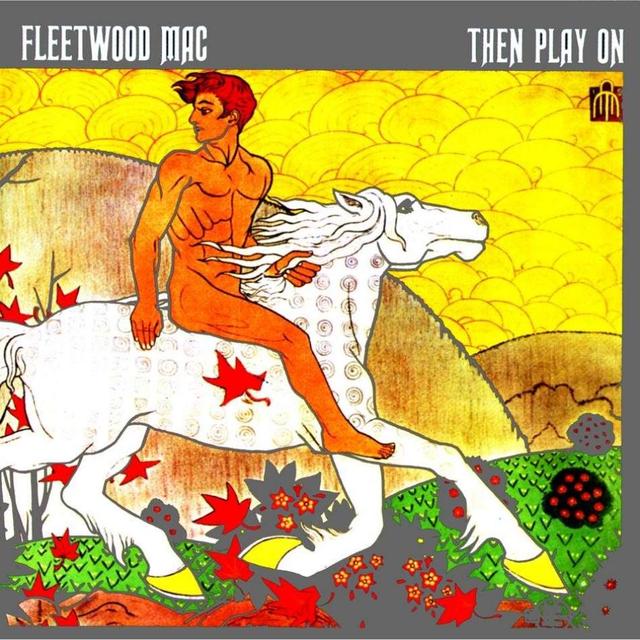
Then Play On

1. Coming Your Way
2. Closing My Eyes
3. Showbiz Blues
4. My Dream
5. Underway
6. Oh Well
7. Although the Sun is Shing
8. Rattlesnake Shake
9. Searching for Madge
10.Fighting for Madge
11.When You Say
12.Like Crying Like Dying
13.Before the Beginning
It is often (and mistakenly) claimed that Fleetwood Mac remained a straightforward blues outfit until the sun-kissed arrival of Lindsey Buckingham and Stevie Nicks in 1975. Then Play On, released in 1969, dismantles that myth in glorious fashion. This is not the sound of a band wading through its blues apprenticeship. This is a band reinventing itself—boldly, eccentrically, and with no concern for commercial tidiness.
Gone, for the most part, are the Elmore James pastiches and pub circuit boogie-woogie. In their place: expansive guitar workouts, genre-melding flourishes, and the first glimpses of the haunted introspection that would later define the group’s darker masterpieces. Then Play On is not only the band’s most progressive early work—it may well be their most creatively ambitious album full stop.
The addition of Danny Kirwan (this time fully integrated) proved transformative. With Jeremy Spencer effectively sidelined (he appears nowhere on the album proper), the interplay between Kirwan and Peter Green becomes the record’s heartbeat. The pair trade compositions like friendly rivals, each delivering material that draws from blues, folk, psychedelia, and hard rock, without ever feeling stitched together.
Kirwan’s presence is immediately asserted on the opener, Coming Your Way—a tumbling, tribal groove decorated with Latin percussion and eerie vibrato-laden guitars. It’s a thrilling, unexpected start, and one that sets the tone for an album that refuses to stay in any one lane for long. His other contributions—Although the Sun is Shining and My Dream—drift closer to the melodic melancholy that would become his hallmark. They are beautiful, if slightly disoriented, works—brimming with that late-sixties mix of cosmic optimism and encroaching malaise.
Green, meanwhile, handles the heavier material, and in doing so delivers some of the strongest moments of his storied career. Rattlesnake Shake is gloriously unkempt, riding a sleazy riff and lewd lyric to exhilarating effect. But it is Oh Well that looms largest. Originally released as a single in two parts, it appears here in its entirety, and the contrast is startling. The opening section (Part One) is a taut, driving rocker—anchored by one of Green’s most iconic riffs and an urgent, almost manic vocal. Then, without warning, the piece dissolves into Part Two: six minutes of Baroque acoustic themes, piano interludes, and quasi-orchestral meandering. Whether this juxtaposition is visionary or indulgent depends entirely on one's appetite for genre collisions. At the very least, it shows Green striving for something more—a broader canvas, a deeper mood.
And speaking of indulgence, Searching for Madge and Fighting for Madge are back-to-back instrumental jams attributed to McVie and Fleetwood (respectively), though clearly intended as showcases for the entire band. Essentially two halves of a single extended improvisation, the tracks fade into and out of each other with little ceremony. At nine minutes plus, this is Fleetwood Mac at their most freeform—a snapshot of the late sixties studio-as-playground ethos, complete with all the spaciness and swagger one would expect.
Clocking in at nearly 54 minutes, Then Play On was unusually lengthy for a single LP of its time—more so given its lack of filler. Every track is a bona fide artistic statement, even when it doesn’t quite work. There is a generosity of ambition here, a sense that the band was not merely writing songs, but trying to carve out a new identity altogether.
In hindsight, the triumph of Then Play On is tinged with tragedy. It was the last Fleetwood Mac album to feature Peter Green, and though no one could have guessed it at the time, it would also mark the end of the band’s first great era. In the years that followed, each of the group’s three guitarists would experience breakdowns or disappearances of one kind or another. Green’s was the first, and the most profound. His departure left a void the band would spend the next several years trying to navigate.
And yet, Then Play On remains. It is, quite simply, one of Fleetwood Mac’s finest achievements. If Rumours was the band’s commercial zenith, Then Play On was its artistic crucible—messy, inspired, and utterly essential. Were one stranded on a desert island with room for only a handful of Mac records, this would surely be among them.
Go back to the main page
Go To Next Review